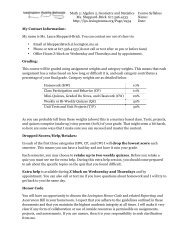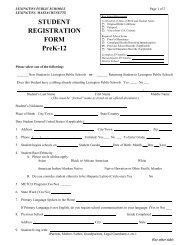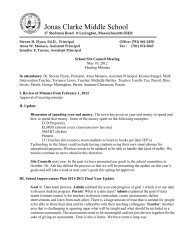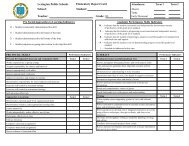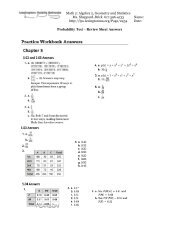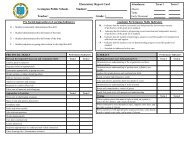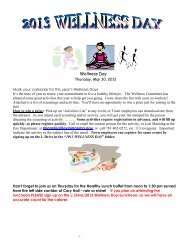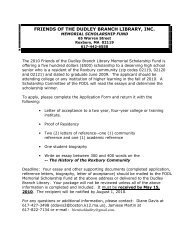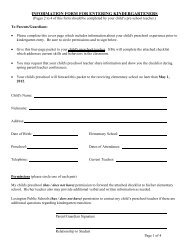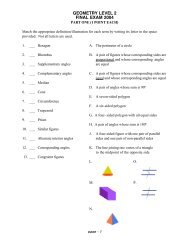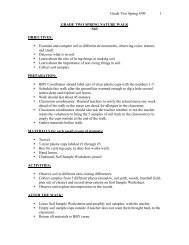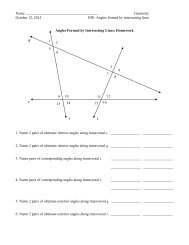Winter Big Backyard Walk - Lexington Public Schools
Winter Big Backyard Walk - Lexington Public Schools
Winter Big Backyard Walk - Lexington Public Schools
Create successful ePaper yourself
Turn your PDF publications into a flip-book with our unique Google optimized e-Paper software.
Grade Two <strong>Winter</strong> 1/09 1<br />
GRADE TWO WINTER NATURE WALK<br />
Using Thermometers<br />
OBJECTIVES:<br />
• Use thermometers to measure temperature.<br />
• Compare temperature of air and water inside and outside the school.<br />
• Relate temperature to the state of water: solid or liquid<br />
• Discover locations of highest and lowest temperature outside.<br />
• Recognize the effect of temperature on the winter survival of animals.<br />
PREPARATION:<br />
• Room coordinator schedules walk for January, February, or early March.<br />
• If possible, schedule walk after morning or lunch recess so that the air is<br />
warm and some melting might have taken place. <strong>Walk</strong> should last about 30<br />
minutes. <strong>Winter</strong> walks are always shorter than spring and fall ones. Don't stay<br />
out longer than the comfort level of the children allows.<br />
• Be sure children are dressed appropriately.<br />
MATERIALS:<br />
• Thermometers (2 or more per group). Should have both Fahrenheit and Celsius<br />
scales.<br />
• Tissues or paper towel to dry thermometer bulb if it gets wet.<br />
• Clipboard, “Temperature Report: Our <strong>Big</strong> <strong>Backyard</strong>” worksheet, and pencil.<br />
• Trowel (for ice and soil).<br />
• Hand lenses (2-3 or more per group).<br />
• Optional—for snow and ice: 4” x 4” squares of black paper for observing snow<br />
crystals (2-3 per group).<br />
ACTIVITIES<br />
• Measure indoor and outdoor air temperature.<br />
• Find water outside, note whether it is solid or liquid, and measure its temperature.<br />
Locate places where water is frozen and places where it has melted and try to<br />
explain why this has happened.<br />
• Brainstorm places in the schoolyard that might have the highest and lowest<br />
temperature, and measure the temperature of a few of these.<br />
• Relate air or ground temperature to the ways animals survive in winter.
2<br />
Grade Two <strong>Winter</strong> 1/09<br />
PRE-WALK ACTIVITIES: TO BE LED BY THE TEACHER<br />
1. Mathematics Connection: Temperature measurement. (ESSENTIAL.)<br />
Plan to teach the following Everyday Mathematics lessons before the Grade 2 winter<br />
walk:<br />
Lesson 1-12, Reading a thermometer, Home Link master 1-12.<br />
Lesson 4-3, Exploring Temperature.<br />
Lesson 4-4, Temperature Changes.<br />
Math Journal 1, pg. 87, 90, 91. (Activities that follow supplement the journal pages.)<br />
2. Science/Mathematics Connection: Measuring Temperature Activity. (ESSENTIAL.)<br />
(See Activity pg. 271 in the EDM teacher guide: Writing Number Stories about<br />
Thermometer Experiments.)<br />
Materials needed for each group of 2-3 students:<br />
(Most of these materials can be found in the <strong>Big</strong> <strong>Backyard</strong> supply area. Coordinate with<br />
your grade level colleagues so that the materials are available to take outside when<br />
students go out on their walks.)<br />
• 1 plastic or metal backed thermometer (Fahrenheit and Celsius scale).<br />
• 1 clear plastic cup with water and ice or snow.<br />
• A clock or timer for the class.<br />
• Student worksheet, Measuring Temperature.<br />
Activity:<br />
• Distribute the student sheets, Measuring Temperature. Ask: What scientific<br />
instrument can help show you how warm or cool something is (Thermometer.)<br />
Tell students that they will use thermometers to measure the temperature of the air<br />
in the room.<br />
CAUTION: Remind students that the glass part of the thermometer can break and<br />
that they need to handle the thermometer with care. (The red liquid inside is<br />
alcohol and does not pose a hazard.)<br />
• Demonstrate how to hold the thermometer by the metal edges rather than by the<br />
bulb. Ask: Why not hold the bulb (You would measure your finger<br />
temperature!)<br />
• Remind the students to be sure that the bulb of the thermometer is dry when<br />
measuring air temperature. If the bulb is wet, dry the thermometer bulb with the<br />
tissue before using it to measure air temperature. If there is water remaining on<br />
the bulb, until it completely evaporates, the temperature reading will be lower<br />
than the air temperature.
Grade Two <strong>Winter</strong> 1/09 3<br />
• Invite groups of 2-3 children to practice using a thermometer to tell the<br />
temperature of the air in the room. Each child should have a chance to read the<br />
thermometer. Have them shade in the picture of the thermometer on the attached<br />
student sheet to show the air temperature and write in the temperature in the space<br />
provided. Ask: Is all the air in the room the same temperature If not, why do<br />
you think it is not (Heater, draft, etc.)<br />
• In addition, have students measure and record the temperature of ice and water.<br />
(It should be near 32ºF or 0ºC). Ask children to notice what happens to the level<br />
of the red liquid when the thermometer is placed in ice water. Have them watch<br />
as the level gets lower and lower. Record how long it takes before the level no<br />
longer changes. (It may be a few minutes.) If necessary, help students read the<br />
thermometer scale. Note that each mark on the ºF side represents 2 degrees. You<br />
might point this out on the student sheet.<br />
• You may want to have students add some other points to the large thermometer on<br />
the student sheet: freezing point of water, human body temperature, etc.<br />
• If you have time, allow the ice to melt and the resulting water to come to room<br />
temperature. Ask students to measure the temperature of the water in the cup as it<br />
warms up. Ask: What makes ice turn to liquid water (Heat from the room is<br />
added.) How could we make the water change back to ice (Cool it; lower its<br />
temperature in a refrigerator or outside.)<br />
Tell children that they will go outside on their <strong>Big</strong> <strong>Backyard</strong> walk to look for water and measure<br />
the temperature of air and water and other things. Ask: Where can we find water outside<br />
today Do you think the water we find outside will be a solid or liquid today Why What<br />
place do you think will be warmest outside Coldest<br />
3. Science Connection: Changes--Properties of Water. (Lessons 1, 2, and 5.)<br />
Ask questions such as:<br />
What do you know about water<br />
What does water look like What color is water<br />
What does it feel like Is it soft or hard<br />
Can you hold water in your hand<br />
Is water runny or can you pick up a piece<br />
Can you walk on water<br />
Is water hot or cold<br />
Summarize by saying:<br />
Sometimes water is clear and you can see through it, like a rain drop. Sometimes water is<br />
cloudy, or different colors when things like salt or dirt or food coloring dissolve in it.<br />
Sometimes it looks white when it is snow.
4<br />
Grade Two <strong>Winter</strong> 1/09<br />
Sometimes water is runny and goes through our fingers when we try to pick it up. That’s when<br />
it is a liquid. But sometimes water becomes solid and hard, and then we can pick up a piece of<br />
solid frozen water or a snowflake.<br />
Ask: What can you do to change water from a solid to a liquid What would you do to melt an<br />
ice cube (Make it warmer; add heat.) How could you make the water change back into an ice<br />
cube (Make it colder; take away heat.) (See Lesson 2, Changes.)
Grade Two <strong>Winter</strong> 1/09 5<br />
NAME____________________________<br />
Measuring Temperature<br />
Measure the temperature of the air in the room.<br />
Color in the thermometer below to show<br />
the temperature. Write the temperature.<br />
Measure the temperature of water<br />
and ice in the cup. Color the<br />
thermometer below to show the<br />
temperature.<br />
AIR TEMPERATURE _______ºF<br />
WATER AND ICE ________ºF<br />
Draw a line on the thermometer below to show CLASSROOM AIR TEMPERATURE<br />
Draw a line on the thermometer below to show WATER AND ICE TEMPERATURE<br />
CLASSROOM AIR<br />
WATER AND ICE
6<br />
Grade Two <strong>Winter</strong> 1/09
Grade Two <strong>Winter</strong> 1/09 7<br />
NATURE WALK: TO BE LED BY BIG BACKYARD VOLUNTEER<br />
1. Measuring temperatures inside the school.<br />
• Measure the air temperature in the hallway and/or classroom while you walk toward<br />
the outside door. <strong>Walk</strong> leaders: Record all temperatures on the walk worksheet.<br />
• As appropriate, review the following (from classroom activity led by teacher):<br />
o CAUTION: Remind students that the glass part of the thermometer can break and<br />
that they need to handle the thermometer with care. (The red liquid inside is<br />
alcohol and does not pose a hazard.)<br />
o It may take several minutes for the thermometers to adjust to each new location.<br />
o Hold the thermometer by the plastic or metal edges so fingers do not warm the<br />
glass.<br />
o Dry the thermometer bulb before using it to read air temperature. (If there is<br />
water remaining on the bulb, the temperature reading will be lower than the air<br />
temperature until the water completely evaporates.)<br />
• Ask: Do you think the air outside will be a lower temperature or a higher<br />
temperature than inside air today What do you think the outside temperature will<br />
be Do you think the water we find outside will be a solid or liquid today Why<br />
2. Measuring temperatures outside the school.<br />
• Tell students that they will measure the temperature of air, water and other things<br />
outside the school. Just outside the school, have your group measure the air<br />
temperature in degrees Fahrenheit. Try to shield the bulb from direct sunlight with a<br />
clipboard or hand. It will take a few minutes for the thermometer to stabilize. Go on<br />
to the next discussion point while waiting. Return to record this temperature.<br />
• Ask the children: Where do you think the temperature is highest Where is it lowest<br />
Have children look all around the schoolyard for places they think will have a higher<br />
or lower temperature than the one they just recorded. In addition, challenge them to<br />
find some water (snowdrifts, ice, puddles, mud, icicles, etc.). Remind them that water<br />
is sometimes a solid and sometimes a liquid. As a group, decide on several areas to<br />
investigate.<br />
• Possible locations:<br />
o Under leaves or a log. (If dark colored leaves are on top of the snow, they<br />
sometimes melt into the surface, leaving a leaf print.)<br />
o On the asphalt black top. (Bare, or with snow, ice, or puddles.)<br />
o Under the soil. (Use the trowel to make a hole for the thermometer.)<br />
o Inside a snow bank. (Use the trowel. Try different depths. Snow actually keeps<br />
temperatures from going much below freezing, as it is a good insulator.)<br />
o On top of a snow bank.
8<br />
Grade Two <strong>Winter</strong> 1/09<br />
o Sunny spot vs. shade. (Remember to shield the bulb from direct sun.)<br />
o Under or on the playground equipment.<br />
o Field vs. woods.<br />
o Near a dark colored tree surrounded by snow. (There is usually a melted area<br />
near the trunk—the dark trunk absorbs sunlight and heats up slightly more than<br />
the white snow.)<br />
• Go to 3-4 of these places with your group and measure the temperature. You may<br />
want to leave thermometers in several places at once and return after a few minutes to<br />
take readings. Be sure to gently dry the thermometer bulb with tissue if it gets wet.<br />
While you are waiting for thermometers to register, invite children to use their bare<br />
fingers to briefly feel a spot and sense the degree of warmth. <strong>Walk</strong> leaders record<br />
findings on the worksheet. If water temperature is measured, record the state of the<br />
water: solid or liquid.<br />
• Optional: Examine snow or ice crystals.<br />
o Ask students to put a little snow or ice on black paper, and examine it with a hand<br />
lens. Invite them to describe its properties.<br />
o Ask: How can you change snow or ice Have them (or you if you think that<br />
throwing snowballs is too tempting for your group!) take a bare handful of snow<br />
or ice and squeeze it to see what happens. Ask: Why does the snow change to<br />
liquid water (Heat from their hand raises the temperature of the snow above the<br />
freezing point.)<br />
3. Animals in winter.<br />
• Ask: How do you stay warm when the outside air temperature is low (Coats,<br />
mittens, go inside, etc.)<br />
• Ask: If you were an animal, where would you go in the schoolyard to stay warm<br />
today Where would you find liquid water to drink Invite children to give examples<br />
of how animals stay warm in the winter. (Migrate to a warmer place, grow thicker<br />
fur, find a shelter, perhaps underground.) Some animals survive over the winter by<br />
finding a slightly warmer place that protects them from the cold and allows them to<br />
find liquid water. Snow actually acts like a blanket that keeps the ground below from<br />
getting even colder. Tunnels underground can reach a place that is not so cold.<br />
4. Wrap up.<br />
• List all children’s observations and questions. Ask: Where was the highest<br />
temperature outside Where was the lowest What do you think made the<br />
difference<br />
• <strong>Walk</strong> back to the school.<br />
• Give the “Temperature Report: Our <strong>Big</strong> <strong>Backyard</strong>” worksheet to the teacher.<br />
• Return all materials to the <strong>Big</strong> <strong>Backyard</strong> supply area.
Grade Two <strong>Winter</strong> 1/09 9<br />
TEMPERATURE REPORT: OUR BIG BACKYARD<br />
GROUP LEADER: DATE: TIME:<br />
Indoor air temperature: __________ºF<br />
Outside air near school: __________ºF<br />
LOCATION<br />
TEMP. OF WATER<br />
Solid or Liquid<br />
TEMP. OF OTHER MATERIAL<br />
(air, soil, blacktop, etc.)<br />
Where do you think an animal would go in the schoolyard to find the highest temperature today<br />
Where do you think an animal would go to find liquid water to drink today<br />
Most surprising discoveries:<br />
Questions we still have:
10<br />
Grade Two <strong>Winter</strong> 1/09<br />
POST-WALK CURRICULUM INTEGRATION OPPOPTUNITIES: TO BE<br />
CHOSEN AND LED BY THE TEACHER<br />
1. Literacy Connection: <strong>Winter</strong> Number Story.<br />
Write a winter story about two days in an animal’s life in your school’s <strong>Big</strong> <strong>Backyard</strong>. On<br />
one day, the air temperature at noon is 50ºF and the next day it is 25ºF. Include ways the<br />
animal stays warm and where and when it finds liquid water. Include at least one<br />
temperature reading in your story.<br />
2. Science Connection: Changes, Lesson 2.<br />
• Ask: Are some locations outside warmer than others even on a cold winter day Why do<br />
you think this is so (Insulation of soil, snow, or grass, heat from school building, heat<br />
from dark asphalt.)<br />
• Ask: Why do you think you found snow and ice in some places and not in other places<br />
What is the evidence for your explanation (How did you decide on your idea) Snow<br />
removed by plowing and shoveling is obvious. Wind can also move snow. Ask: How<br />
do shadows affect the temperature of ice or snow (Encourage them to use data they<br />
collected on the walk to show that the temperature of air in the shade is lower than air in<br />
the sun.) Also ask how temperature might be affected by sunshine falling on dark vs.<br />
light colored objects. In Grade 1 they should have learned that dark colored objects<br />
(black top, tree trunks, or dead leaves on the snow) are heated more by the sun than light<br />
colored objects (from Grade 1 lesson from the Investigating Light and Shadow unit).<br />
Even in winter, water can evaporate (as in Lesson 2).<br />
• Ask: What do you think makes snow and ice turn to water on the playground (Higher<br />
air temperatures, warmer soil or warm blacktop.) Where does that water go (Water<br />
evaporates into the air, but this concept is difficult for second graders—accept all<br />
answers that have a logical, even if not correct, explanation.)<br />
• Ask: Why do we get rain in summer and snow only in winter (Air temperature is above<br />
the freezing point of water, 32ºF, in the summer, so ice cannot form.)<br />
3. Science Connection: Changes, Lesson 2.<br />
Ice cubes can be put in different places outside as part of the “ice cube melting race.” A<br />
variation on extension 4 in this lesson, page 40, might be to put very warm water in zip lock<br />
bags, instead of ice cubes. Challenge students to find materials that can be used to help the<br />
water in the bag stay warm. They can try different types of insulation, different locations,<br />
etc.<br />
4. Going Further: Ask: When we go out again in the spring, how do you think our<br />
observations on water and temperature will be different If we compare our winter walk<br />
data with other grade 2 classrooms, will it be exactly the same or different Why or why<br />
not (<strong>Walk</strong>s may take place on different days and different times of day.)



